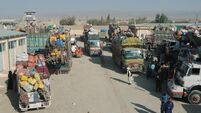Sandy picks up pace, slams US coast

It lashed the densely populated region, shutting down transportation, forcing evacuations in flood-prone areas, and interrupting the presidential campaign.
Fierce winds and flooding racked hundreds of miles of Atlantic coastline and heavy snows were forecast farther inland at higher elevations as the centre of the storm moved ashore along the coast of New Jersey and Delaware last night.














